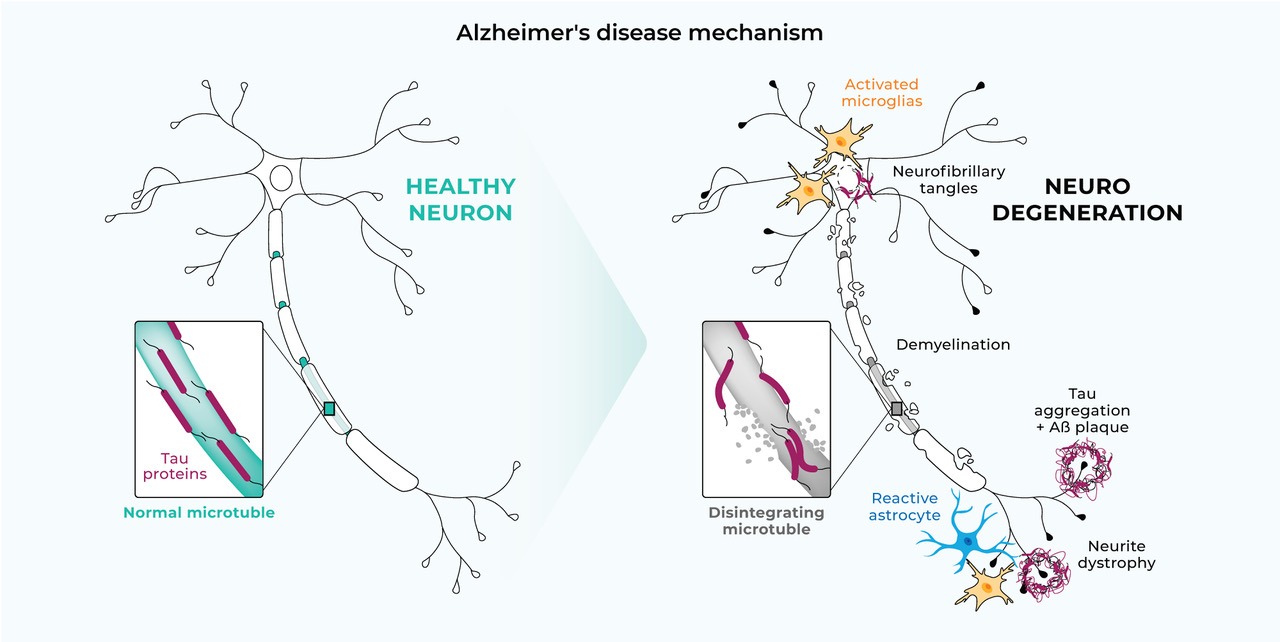Alzheimer’s disease and white matter at a glimpse
What is at stake?
Alzheimer’s disease is a neurodegenerative disorder that stands as the primary cause of dementia, characterized by a gradual progression of neuronal damage. This slow deterioration in neural function leads to the onset and worsening of symptoms over time.
Alzheimer’s disease accounts for over
35.6 million
people worldwide
with
7.7 million
new cases reported annually
To date, only
35%
of people suffering from Alzheimer are diagnosed(1)
This growing prevalence highlights the urgent need for increased research and more effective treatments to combat this debilitating disease.
Why does white matter matter?
This disease presents key pathological features such as amyloid-β deposition and tau pathology. White matter alterations such as demyelination have been proven to appear early and foster the deposit and aggregation of beta amyloid protein, potentially accelerating disease progression(2). It also reflect other pathologic features of Alzheimer’s disease such as neurodegeneration, oligodendrocyte dysfunction and inflammation.
White matter hyperintensities are indicative of vascular health and correlate with an increased risk of dementia. The side effects of new anti amyloid treatments include ARIA (amyloid related imaging abnormalities), linked to vascular conditions and white matter alterations.

How measuring the brain can become a game changer in treatment and drug development?
Measuring neurodegeneration in Alzheimer’s disease through white matter alterations measures enables several significant advancements :
- Patient stratification in clinical trials: white matter changes facilitate the deposition of amyloid plaques, suggesting that the disease may appear and progress more rapidly in patients with altered white matter. Estimating the rate of progression in a patient is crucial for designing clinical trials, as it helps in identifying which patients are most likely to benefit from specific interventions based on their stage of disease progression.
- Early detection of alterations: The assessment of white matter offers a method to detect early alterations that are predictive of clinical progression. This approach serves as an intermediary between current biomarkers, which, despite being very early indicators, often lack strong clinical correlation, and clinical tests that are only relevant at advanced disease stages. By identifying these alterations, clinicians can make objective arguments for initiating treatment and measuring the effectiveness of a treatment during a clinical trial.
References:
1. Rapport de la Fondation Recherche Alzheimer (https://alzheimer-recherche.org/wp-content/uploads/2024/03/Rapport-Prevalence-Maladie-dAlzheimer-apparentees_BVA_fevrier-2024.pdf)
2. Meneses, A., Koga, S., O’Leary, J. et al. TDP-43 Pathology in Alzheimer’s Disease. Mol Neurodegeneration 16, 84 (2021).
BRAINTALE, whose head office is 11 rue de l’Académie 67000 – STRASBOURG, is registered with the Trade and Companies Register under number 840 995 138 RCS STRASBOURG
Last update : 09/07/2024

